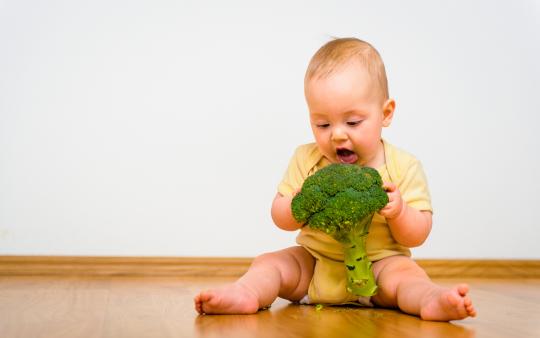One of the most exciting times for parents of babies is that magical moment a spoon is introduced. Suddenly, beautiful jewel-toned baby food jars lining fridge shelves and perfectly cubed pieces of organic produce fill the daydreams of new parents bursting with excitement at the thought of their little one’s next big milestone. However, these reveries can come to a grinding halt as the seemingly monumental task of how exactly to go about starting solid foods becomes a reality. What foods should be introduced first? How much, and in what form? Questions that have parents yearning to return to that easy, exclusively liquid diet of yore!
But before you put that spoon back in the drawer, I’ll let you in on a secret I share with many of my patients: there is no one “right” way to feed your baby. There are many approaches, each with their valid points and benefits, and even healthcare providers haven’t reached a consensus on which is best! When choosing one approach (or a few!) that best works for you, I encourage you to consider your background, values, unique family dynamics, cultural preference, family history, the health of your child, your baby’s birth experience, advice from your health care providers, and more. Figuring out how to feed your baby is just one milestone in a long path of parenting decisions. And if, for whatever reason, what you choose just isn’t working, you can always change your mind! Making an informed decision gathered from trusted sources combined with your unique knowledge of your baby is the best way to embark on the exciting world of solids!

Babies and solid food
Most experts agree that solid food shouldn’t be introduced until at least four months of age. This recommendation is based on nutrition, safety, attachment theory, and the physiological development of the gastrointestinal tract. Recently, there has been talk of starting solids between four and six months, however, the World Health Organization, the American Academy of Pediatrics, and the Canadian Paediatric Society all still recommend the introduction of solids (complementary feeding) at six months of age.
And while six months is a great guideline to consider, there are circumstances that may suggest starting earlier or later. Small size for age or missed milestones may mean extending this timeline a bit, while the appearance of teeth, ability to sit upright unassisted, loss of the tongue reflex (which pushes food out of the mouth in younger babies), ability to handle small objects, and showing visible interest may all be indications that the timeline can be pushed up. Working closely with your healthcare provider to create an individualized solid food introduction will make taking those next big steps a breeze!
Of course, there is even more to consider: Meat or vegetarian? Cooked or raw? Spiced or bland? Organic or conventional? If we let it, this stage in life can make our heads spin. But it’s important to remember that feeding your family, even the smallest members, ideally involves a combination of nourishment, pleasure, and bonding. We can’t always (and shouldn’t) carefully control every aspect, and if something isn’t working, take a new approach. Have fun with your little one, make a bit of a mess, and enjoy the ride, because this phase will pass before you know it!

Introducing food to babies: multiple approaches
There is no one way to feed your baby. The way your parents introduced solids to you may not work for your baby, or the baby next door. If your child is at a heightened risk for food allergies, then your approach might be far more selective than if your child has no known risk and can (and wants to) eat everything in sight! This is where education and individualizing a plan for your child comes into play. The following are some of the most common models of solid food introduction that are aimed at introducing foods to babies with the least negative effects.
Delaying allergens
Delaying allergens is a traditional approach intended to prevent food allergies and sensitivities and involves withholding highly allergenic foods until a child’s immune and digestive systems are more mature.
Allergy-fare aware
A little knowledge is key to safely introducing foods. The most common allergenic foods include cow’s dairy, wheat, egg, soy, tree nuts, fish, shellfish, and citrus. Signs of a food allergy in babies include redness around the mouth or anus, or a sudden change in gastrointestinal health like diarrhea or vomiting. A food sensitivity can present itself in a more general way, with skin disruptions (like rashes or eczema) anywhere on the body or changes in digestion and/or mood.
Early allergen introduction
Early allergen introduction introduces highly allergenic food first with the hopes that it might result in a decrease in allergy development. This is considered especially effective if the child is concurrently breastfed. This is a more recent approach lacking robust, long-term study and not all healthcare providers are convinced. Everyone is keen on decreasing the incidence of food allergies and sensitivities, but the mechanism behind how they develop is not yet fully understood.
Flavour and nutrition first
This places an emphasis on introducing foods based on their nutrition level (e.g. choosing mineral-rich foods first) or their taste (e.g. vegetables before fruits) in hopes of creating better-developed taste buds. Commonly paired with either delayed or early allergen introduction, this approach features food introduction charts outlining what to offer at 6–9 months, 9–12 months, and so on.
Single food introduction
Single food introduction gradually introduces one food at a time as a reliable way of deducing possible food allergy/sensitivity. The food is placed against the cheek first and is followed by a waiting period in case of a reaction. This is often a model for children at high risk of food allergy.
Dive deep on safe food introduction at Introducing Your Baby to Solid Foods Safely and Baby Food Doesn’t Have to be Bland.

Traditional foods introduction
Developed by Weston A. Price, traditional foods introduction is dedicated to building a healthy digestive tract from the earliest point. This approach advocates egg yolks and puréed meats as ideal first foods, followed by specific fruits and veggies, fermented vegetables, and dairy. Grains are delayed until after 12 months of age, and even then are soaked and combined with healthy fats and fermented foods to help with digestion.
For help on building baby’s gut flora, check out The Best Baby Food Diet for Infant Gut Flora.
Family table eating
Family table eating is an informal approach that introduces a variety of foods at once based on what the rest of the family is eating. Oftentimes instituted by parents on their second or third child, this is meant for families who are more relaxed and do not want to sweat the details (or who don’t have time to)!
Initiate healthy habits from the start at ecoparent.ca/healthy-start.
Baby-led weaning
First coined by Gill Rapley in 2005, baby-led weaning promotes infant self-feeding instead of conventional parent spoon-feeding. The baby is offered easily-chewed finger foods and is given control over which and how much of the food they’ll consume. Some evidence shows this leads to more adventurous eaters and can prevent pickiness in older children, although there is concern that there is a higher risk of choking due to the more solid consistency of foods offered.
To investigate baby-led weaning further visit Why You Should Give Baby-Led Weaning a Try.






